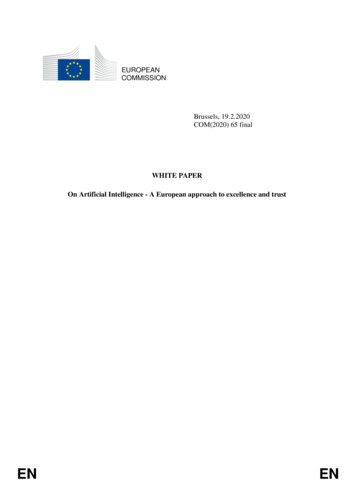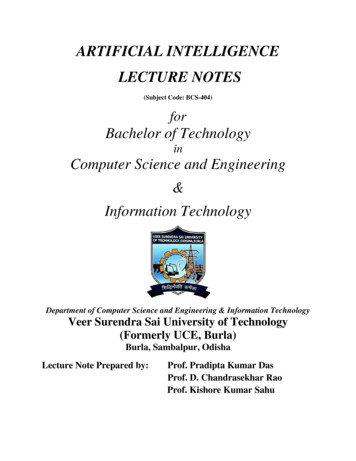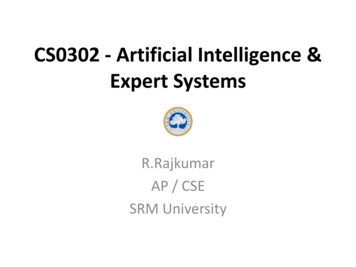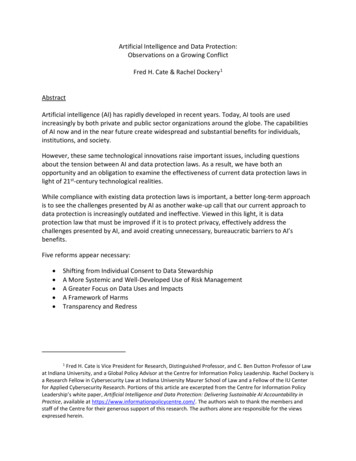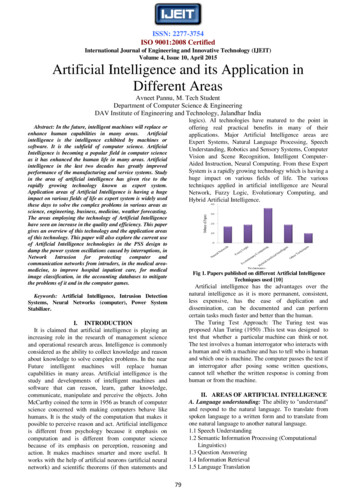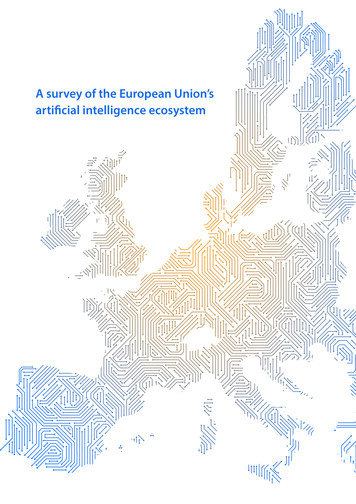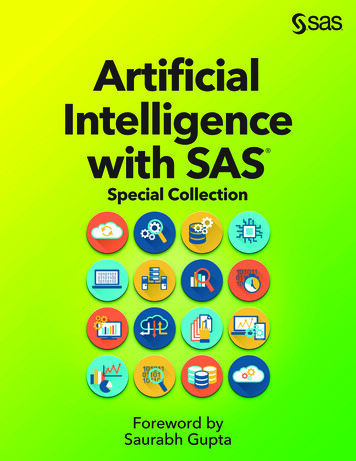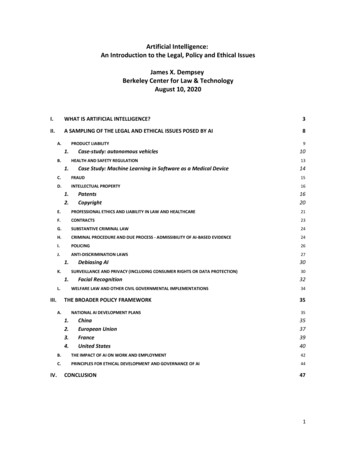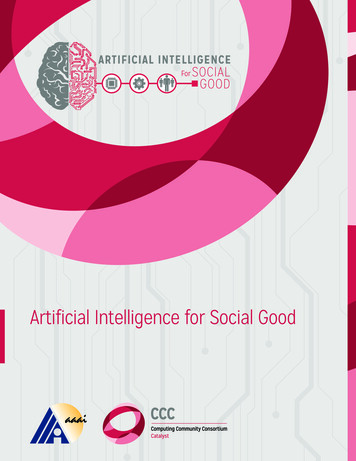
Transcription
Artificial Intelligencein Society
Artificial Intelligencein Society
This document, as well as any data and any map included herein, are without prejudiceto the status of or sovereignty over any territory, to the delimitation of internationalfrontiers and boundaries and to the name of any territory, city or area.Please cite this publication as:OECD (2019), Artificial Intelligence in Society, OECD Publishing, Paris, https://doi.org/10.1787/eedfee77-en.ISBN 978-92-64-58254-5 (print)ISBN 978-92-64-54519-9 (pdf)The statistical data for Israel are supplied by and under the responsibility of the relevant Israeli authorities. The use ofsuch data by the OECD is without prejudice to the status of the Golan Heights, East Jerusalem and Israeli settlements inthe West Bank under the terms of international law.Photo credits: Cover Adobe Stock.Corrigenda to OECD publications may be found on line at: www.oecd.org/about/publishing/corrigenda.htm. OECD 2019You can copy, download or print OECD content for your own use, and you can include excerpts from OECD publications, databases andmultimedia products in your own documents, presentations, blogs, websites and teaching materials, provided that suitableacknowledgement of OECD as source and copyright owner is given. All requests for public or commercial use and translation rights shouldbe submitted to rights@oecd.org. Requests for permission to photocopy portions of this material for public or commercial use shall beaddressed directly to the Copyright Clearance Center (CCC) at info@copyright.com or the Centre français d’exploitation du droit de copie(CFC) at contact@cfcopies.com.
PREFACEPrefaceArtificial intelligence (AI) is reshaping economies, promising to generate productivitygains, improve efficiency and lower costs. It contributes to better lives and helps people makebetter predictions and more informed decisions. These technologies, however, are still intheir infancy, and there remains much promise for AI to address global challenges and promoteinnovation and growth. As AI’s impacts permeate our societies, its transformational powermust be put at the service of people and the planet.At the same time, AI is also fuelling anxieties and ethical concerns. There are questionsabout the trustworthiness of AI systems, including the dangers of codifying and reinforcingexisting biases, such as those related to gender and race, or of infringing on human rights andvalues, such as privacy. Concerns are growing about AI systems exacerbating inequality,climate change, market concentration and the digital divide. No single country or actor hasall the answers to these challenges. We therefore need international co-operation and multistakeholder responses to guide the development and use of AI for the wider good.This book, Artificial Intelligence in Society, examines the AI landscape and highlights keypolicy questions. Its goal is to help build a shared understanding of AI in the present andnear term, and to encourage a broad dialogue on important policy issues, such as labourmarket developments and upskilling for the digital age; privacy; accountability of AIpowered decisions; and the responsibility, security and safety questions that AI generates.The book draws on the work of the AI group of experts at the OECD, formed in 2018 toscope principles to facilitate innovation, adoption and trust in AI. Their debates inspired theOECD Recommendation of the Council on Artificial Intelligence – the first intergovernmentalstandard on AI – adopted by all OECD members and by several partner countries on22 May 2019. This work emphasises the need for international co-operation to shape apolicy environment that fosters trust in and adoption of AI.Looking ahead, we must progress together on AI-related technical, ethical and legal issues,in order to foster the alignment of standards and codes of conduct while ensuring the interoperability of laws and regulations. This is urgent, given the speed of developments andthe breadth of applications. It is thus no surprise that AI is a top priority on national andinternational agendas including in the G7 and G20.Adoption of the Recommendation and creation of a global dialogue are vital first steps. Butthere is much more to be done. With the establishment of the OECD AI Policy Observatorylater this year, we are bringing our analytical, measurement and policy expertise to bear onlargely uncharted territory. The Observatory – an inclusive hub for public policy on AI –will help countries encourage, nurture and monitor the responsible development oftrustworthy AI systems for the benefit of society.ARTIFICIAL INTELLIGENCE IN SOCIETY OECD 2019 3
4 PREFACEMoving forward, the OECD is gearing up to move from principles to action. We aredetermined to help countries implement the Recommendation to ensure that our societiesand economies harness the full promise of AI, sharing its benefits broadly and putting theright safeguards in place so that no one is left behind –now and for generations to come.Angel GurríaSecretary-GeneralOECDARTIFICIAL INTELLIGENCE IN SOCIETY OECD 2019
FOREWORDForewordThis book aims to help build a shared understanding of artificial intelligence (AI) in thepresent and near term. The book maps the economic and social impacts of AI technologiesand applications and their policy implications, presenting evidence and policy options. It isalso intended to help co-ordination and consistency with discussions in other internationalfora, notably the G7, the G20, the European Union and the United Nations.The book builds on the OECD October 2017 Conference “AI: Intelligent Machines, SmartPolicies” (http://oe.cd/ai2017); on the activities and discussions of the AI Group of expertsat the OECD (AIGO) from September 2018 through February 2019; and on the OECDRecommendation of the Council on Artificial Intelligence. In turn, it has contributed to theOECD Going Digital project and the OECD’s publication Going Digital: Shaping Policies,Improving Lives.Chapter 1, “The AI technical landscape”, provides a historical overview of AI’s evolutionfrom the development of symbolic AI in the 1950’s to recent achievements in machinelearning. It presents the work of the OECD’s AI Group of Experts (AIGO) to describe AIsystems – that predict, recommend or decide an outcome to influence the environment –and their lifecycle. The chapter also proposes a research taxonomy to help policy makersunderstand AI trends and identify policy issues.Chapter 2, “The AI economic landscape”, discusses AI’s role as a new general-purposetechnology that can lower the cost of prediction and enable better decisions. Complementaryinvestments in data, skills and digitalised workflows are required, as is the capacity to adaptorganisational processes. The chapter also reviews trends in private equity investment inAI start-ups.Chapter 3, “AI applications”, considers ten areas that are experiencing rapid uptake of AItechnologies – transport, agriculture, finance, marketing and advertising, science, health,criminal justice, security, the public sector and augmented/virtual reality. Benefits of AIuse in these areas include improving the efficiency of decision making, saving costs andenabling better resource allocation.Chapter 4, “Public policy considerations”, reviews salient policy issues that accompany thediffusion of AI. The chapter supports the OECD AI Principles adopted in May 2019, firstin terms of values: inclusive growth, sustainable development and well-being; human-centredvalues and fairness; transparency and explainability; robustness, security and safety; andaccountability. Secondly, it outlines national policies to promote trustworthy AI systems:investing in responsible AI research and development; fostering a digital ecosystem for AI;shaping an enabling policy environment for AI; preparing people for job transformation andbuilding skills; and measuring progress.ARTIFICIAL INTELLIGENCE IN SOCIETY OECD 2019 5
6 FOREWORDChapter 5, “AI policies and initiatives”, illustrates the growing importance of AI in thepolicy agendas of stakeholders at both national and international levels. All stakeholdergroups – governments and inter-governmental organisations, as well as companies, technicalorganisations, academia, civil society and trade unions – are actively engaged in discussionson how to steer AI development and deployment to serve all of society.This book was declassified by the OECD Committee on Digital Economy Policy (CDEP)on 10 April 2019 by written procedure and prepared for publication by the OECD Secretariat.ARTIFICIAL INTELLIGENCE IN SOCIETY OECD 2019
ACKNOWLEDGEMENTSAcknowledgementsThe Artificial Intelligence in Society publication was prepared under the aegis of the OECDCommittee for Digital Economy Policy (CDEP), with input from its working parties. CDEPdelegates contributed significantly with their comments and amendments, as well as bysharing and reviewing their countries’ national AI strategy.The core authors of the publication were Karine Perset, Nobuhisa Nishigata and LuisAranda of the OECD’s Digital Economy Policy Division, with Karine Perset conductingoverall editing and co-ordination. Anne Carblanc, Head of the OECD Digital EconomyPolicy Division; Andrew Wyckoff and Dirk Pilat, respectively Director and Deputy Directorfor Science, Technology and Innovation, provided leadership and oversight. Parts of thebook were researched and drafted by Doaa Abu Elyounes, Gallia Daor, Lawrence Pacewicz,Alistair Nolan, Elettra Ronchi, Carlo Menon, Christian Reimsbach-Kounatze. Guidance,input and comments were provided by experts across the OECD, including Laurent Bernat,Dries Cuijpers, Marie-Agnes Jouanjean, Luke Slawomirski, Mariagrazia Squicciarini,Barbara Ubaldi and Joao Vasconcelos.The book benefited from the contributions of Taylor Reynolds and Jonathan Frankle fromthe MIT Internet Policy Research Initiative; Douglas Frantz, independent consultant; AviGoldfarb from the University of Toronto; Karen Scott from Princeton University; the OECD’sTrade Union Advisory Committee; Amar Ashar, Ryan Budish, Sandra Cortesi, Finale DoshiVelez, Mason Kortz and Jessi Whitby, from the Berkman Klein Center for Internet andSociety at Harvard University; and the members of the AI Group of Experts at the OECD(AIGO). The drafting team wishes in particular to thank Nozha Boujemaa, Marko Grobelnik,James Kurose, Michel Morvan, Carolyn Nguyen, Javier Juárez Mojica and Matt Chensenfortheir valuable inputs and feedback.The book also leverages ongoing work streams throughout the OECD. These include workby the Committee for Scientific and Technological Policy and its Working Party on Innovationand Technology Policy; the Committee on Consumer Policy and its Working Party onConsumer Product Safety; the Committee on Industry, Innovation and Entrepreneurshipand its Working Party on Industrial Analysis; the Employment, Labour and Social AffairsCommittee; the Education Policy Committee; and the e-leaders initiative of the PublicGovernance Committee and the Competition Committee, in addition to the Committee onDigital Economy Policy and its working parties, notably the Working Party on Securityand Privacy in the Digital Economy.The authors are also grateful to Mark Foss for editing this publication, and to Alice Weberand Angela Gosmann for editorial support. The publication’s overall quality benefited fromtheir engagement.The support of the Japanese Ministry for Information and Communications (MIC) for thisproject is gratefully acknowledged.ARTIFICIAL INTELLIGENCE IN SOCIETY OECD 2019 7
TABLE OF CONTENTS 9Table of contentsPreface . 3Foreword . 5Acknowledgements . 7Acronyms, abbreviations and currencies . 13Executive summary . 15Machine learning, big data and computing power have enabled recent AI progress. 15AI systems predict, recommend or decide an outcome to influence the environment. 15AI can improve productivity and help solve complex problems . 15AI investment and business development are growing rapidly . 15AI applications abound, from transport to science to health. 16Trustworthy AI is key to reaping AI’s benefits . 16AI is a growing policy priority for all stakeholders . 171. The technical landscape . 19A short history of artificial intelligence . 20What is AI? . 22The AI system lifecycle . 25AI research . 26References. 33Notes . 342. The economic landscape. 35Economic characteristics of artificial intelligence . 36Private equity investments in AI start-ups . 37Broader trends in development and diffusion of AI . 44References. 45Note. 463. AI applications . 47AI in transportation with autonomous vehicles . 48AI in agriculture . 52AI in financial services . 55AI in marketing and advertising . 58AI in science . 59AI in health . 61AI in criminal justice . 64AI in security . 67AI in the public sector . 70AI applications using augmented and virtual reality . 70ARTIFICIAL INTELLIGENCE IN SOCIETY OECD 2019
10 TABLE OF CONTENTSReferences. 72Notes . 804. Public policy considerations . 81Human-centred AI . 82Inclusive and sustainable growth and well-being . 83Human-centred values and fairness . 84Transparency and explainability . 91Robustness, security and safety . 95Accountability. 99AI policy environment . 100Investment in AI research and development . 100Enabling digital ecosystem for AI . 100Policy environment for AI innovation . 105Preparing for job transformation and building skills . 106Measurement. 111References. 112Notes . 1205. AI policies and initiatives . 121Artificial intelligence for economic competitiveness: Strategies and action plans . 122Principles for AI in society . 122National initiatives . 124Intergovernmental initiatives . 136Private stakeholder initiatives . 140References. 144Notes . 148TablesTable 1.1. Cluster 1: Application areas . 28Table 1.2. Cluster 2: ML techniques . 29Table 1.3. Cluster 3: Ways of improving ML/optimisations . 30Table 1.4. Cluster 4: Refining ML with context. 32Table 2.1. Average amount raised per deal, for deals up to USD 100 million . 43Table 2.2. Average amount raised per deal, for all AI deals . 43Table 3.1. A selection of AI start-ups in agriculture . 54Table 4.1. Approaches to improve the transparency and accountability of AI systems . 92Table 5.1. Selection of sets of guidelines for AI developed by stakeholders (non-exhaustive) . 123Table 5.2. R&D Principles provided in the AI R&D Guidelines . 131Table 5.3. General Principles contained in the IEEE’s Ethically Aligned Design (version 2). 141Table 5.4. Asilomar AI Principles (excerpt titles of the principles) . 142Table 5.5. ITI AI Policy Principles . 142Table 5.6. Top 10 Principles for Ethical Artificial Intelligence (UNI Global Union) . 143FiguresFigure 1.1. Timeline of early AI developments (1950s to 2000) . 20Figure 1.2. AlphaGo’s rapid self-learning to become best Go player in the world in 40 days . 21ARTIFICIAL INTELLIGENCE IN SOCIETY OECD 2019
TABLE OF CONTENTS 11Figure 1.3. A high-level conceptual view of an AI system . 23Figure 1.4. Detailed conceptual view of an AI System . 23Figure 1.5. AI system lifecycle. 26Figure 1.6. The relationship between AI and ML . 27Figure 1.7. Training a machine using a computer’s camera . 31Figure 2.1. Total estimated investments in AI start-ups, 2011-17 and first semester 2018 . 38Figure 2.2. AI as a share of private equity investments in start-ups, 2011 to 2017 and first semester2018 . 40Figure 2.3. Private equity investments in AI start-ups based in the European Union, 2011 to mid2018 . 41Figure 2.4. Number of private equity investments in AI start-ups, by start-up location . 42Figure 2.5. Size of investment transactions, 2012-17 and first semester 2018 . 43Figure 3.1. Cost comparison of different modes with and without AV technology . 48Figure 3.2. Patent filings related to AVs by company, 2011-16 . 49Figure 3.3. Examples of satellite data use for better monitoring . 53Figure 3.4. Illustration of face-recognition software . 69Figure 4.1. Illustration of data-visualisation tools to augment explainability . 94Figure 4.2. A small perturbation tricks an algorithm into classifying a panda as a gibbon. 97BoxesBox 1.1. Artificial narrow intelligence versus artificial general intelligence . 22Box 1.2. Teachable Machine . 31Box 2.1. Methodological note . 39Box 3.1. Using AI to manage digital security risk in business environments . 68Box 3.2. Surveillance with “smart” cameras . 68Box 3.3. Face recognition as a tool for surveillance . 69Box 4.1. “Black box” AI systems present new challenges from previous technologicaladvancements . 82Box 4.2. Human rights and AI. 84Box 4.3. Human rights impact assessments . 86Box 4.4. The OECD Privacy Guidelines . 88Box 4.5. Addressing explainability issues through better-designed user interfaces. 94Box 4.6. The peril of adversarial examples for ML . 97Box 4.7. Synthetic data for safer and more accurate AI: The case of autonomous vehicles . 98Box 4.8. New cryptographic tools enable privacy-preserving computation . 103Box 4.9. Blockchain for privacy-preserving identity verification in AI. 103Box 5.1. How do countries seek to develop competitive advantage in AI? . 124ARTIFICIAL INTELLIGENCE IN SOCIETY OECD 2019
ACRONYMS, ABBREVIATIONS AND CURRENCIESAcronyms, abbreviations and currenciesAGIArtificial general intelligenceAIArtificial intelligenceAI HLEG High-Level Expert Group on AI (European Commission)AIGOAI Group of Experts (OECD)AINEDDutch public-private partnership “AI for the Netherlands”AISAutonomous and intelligent systemANIArtificial narrow intelligenceARAugmented realityAUDAustralian dollarAVAutonomous vehicleCADCanadian dollarCHFSwiss francCoECouncil of EuropeCTRClick-through rateDKKDanish kroneECEuropean CommissionEESCEuropean Economic and Social CommitteeEHRElectronic health recordEUREuroFICOFair, Isaac and CompanyG20Group of TwentyG7Group of SevenGBPBritish poundGDPRGeneral Data Protection Regulation (European Union)GMGeneral MotorsHoMEHousehold Multimodal EnvironmentHRIAHuman rights impact assessmentIECInternational Electrotechnical CommissionARTIFICIAL INTELLIGENCE IN SOCIETY OECD 2019 13
14 ACRONYMS, ABBREVIATIONS AND CURRENCIESIEEEInstitute for Electrical and Electronics EngineersIoTInternet of ThingsIPIntellectual propertyIPRsIntellectual property rightsIPRIInternet Policy Research Initiative (Massachusetts Institute of Technology)ISOInternational Organization for StandardizationITIInformation Technology Industry CouncilKRWKorean wonMITMassachusetts Institute of TechnologyMLMachine learningMPCSecure multi-party computationMPIMax Planck Institute for Innovation and CompetitionNLPNatural language processingNOKNorwegian kroneOAIOffice for Artificial Intelligence (United Kingdom)PAIPartnership on Artificial Intelligence to Benefit People and SocietyPIAACProgramme for the International Assessment of Adult Competencies (OECD)R&DResearch and developmentRMBYuan renminbiSAESociety of Automotive EngineersSARSaudi riyalSDGsSustainable Development Goals (United Nations)SMEsSmall and medium-sized enterprisesSTEMScience, technology, engineering and mathematicsUGAIUniversal Guidelines on Artificial IntelligenceUSDUS dollarVRVirtual realityARTIFICIAL INTELLIGENCE IN SOCIETY OECD 2019
EXECUTIVE SUMMARYExecutive summaryMachine learning, big data and computing power have enabled recent AI progressThe artificial intelligence (AI) technical landscape has evolved significantly from 1950when Alan Turing first posed the question of whether machines can think. Coined as a termin 1956, AI has evolved from symbolic AI where humans built logic-based systems,through the AI “winter” of the 1970s to the chess-playing computer Deep Blue in the 1990s.Since 2011, breakthroughs in “machine learning” (ML), an AI subset that uses a statisticalapproach, have been improving machines ability to make predictions from historical data.The maturity of a ML modelling technique called “neural networks”, along with largedatasets and computing power, is behind the expansion in AI development.AI systems predict, recommend or decide an outcome to influence the environmentAn AI system, as explained by the OECD’s AI Experts Group (AIGO), is amachine-based system that can, for a given set of human-defined objectives, makepredictions, recommendations or decisions influencing real or virtual environments. Ituses machine and/or human-based inputs to perceive real and/or virt
stakeholder responses to guide the development and use of AI for the wider good. This book, Artificial Intelligence in Society, examines the AI landscape and highlights key policy questions. Its goal is to help build a share
